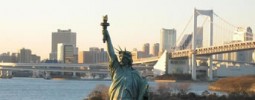Natal, the largest city of Rio Grande do Norte, a northeastern state in Brazil. The city is located on the Atlantic coast and worldwide known for its beaches. Natal was first settlements took place in the 1500s, yet unlike other Northeastern capitals it did not benefit from steady economic growth in the region’s sugar cane product. Instead it grew moderately to become the state’s capital city. As of latest measurement the city has a population of 810 thousand people.
During the second world war Natal hosted a United States military base because of the its strategic position far east on the Atlantic. Nowadays is the city of Natal a popular travel destination for Brazilians and foreign tourists, offering long stretched beaches, fine restaurants offering local and international cuisine and of course good rated hotels. When traveling to Natal, you can get in through Augusto Severo International Airport, about 12 miles from the city center. There’s numerous direct flights from the most important Brazilian capitals such as; Sao Paulo, Rio de Janeiro and Brasilia.
Once you arrived in Natal, it’s easy to get around using taxi’s, public buses are less convenient yet cheaper. There’s several sightseeing’s that may not be missed in a trip to Natal, include the Orte dos Reis Magos built in 1598, a star shaped fort on the northern tip of the beach. As well the picture worthy sunset of Potengy River, it’s breathtaking and brings a highlight in your day. Further more the city offers multiple beaches which can be reached by buggy including; Zumbi beach (North), Genipabu beach (North) and Barra de Cunhaú beach (South).
Travelers landing on Presidente Juscelino Kubitschek International Airport require a valid passport and visa. Tourist visas are valid for 90 days and can be extended for another 90 days. Traffic in the city is complicated due to certain regulations. The city has low crime problems, yet always be careful. Avoid extravagant or expensive-looking clothing to stand out in the crowd.
The capital of Brazil in the central west region is a masterpiece of modern architecture. Brasilia was inaugurated in 1960 in the Central Highlands of the country along the plateau Planalto Central. Brasilia was built because president Kubitchek decided the country needed a monumental capital. After the start of building in 1956 the urban planning was built in four years time. Today Brasilia has a population of more than 2.5 million people.
Brasilia is a true modern utopia. It is home to all three branches of Brazilian government and the headquarters of many Brazilian companies. The city has a planned design in the shape of a giant bird or airplane. Various separated zones are assigned for specific functions. The city is still developing its own culture. Many Brazilians are proud of their futuristic capital and marvelous architecture. The city is listed as a World Heritage Site of UNESCO.
Brasilia has many architectural sites. The Monumental Axis in the center is the start for many other modern architectural buildings. The Square of the Three Powers houses the three highest authorities. The Palace of Justice, the Itamaraty Palace, the Palace of Dawn, the Brasilia Cathedral, the National Theater and the Juscelino Kubitschek Memorial are all close to the Monumental Axis. The city lacks major museums, but it has cultural centers and contemporary arts scenes. Brasilia also has nature attractions, such as the Paranoa Lake, the City Park and the Brasilia National Park.
Travelers landing on Presidente Juscelino Kubitschek International Airport require a valid passport and visa. Tourist visas are valid for 90 days and can be extended for another 90 days. The restaurants and bars are located in the smaller neighborhood centers, the wings of the airplane.
Arraial d Ajuda is a village in the south of Brazil, located in the state Bahia. It is located on a rock. Arraial da Adjuda is part of Porto Seguro, where the Portuguese first arrived more than 500 years ago. To get to the village people have to cross the Buranhém River in a ferry boat from Porto Seguro.
Arraial d Ajuda is located in a region with endless beaches, light blue water and sun all year round. You can enjoy walks on the beach near the village. The surroundings offer peach and relaxation. In the night there are lots of parties that start after midnight until the morning. During the day you can take boat trips or explore deserted beaches. Travelers can also try Capoeira lessons, Zouk lessons and Afro dance.
There are lots of nearby villages to visit, such as Lagoa Azul, Trancoso, Praia do Espelho with one of the 10 most beautiful beaches in Brazil, and Caraiva. Porto Seguro has a historical center. Here the first church in Brazil was built. On the way to Trancoso you will come across the reserve of the Pataxo Indians. Spend some days here to learn about their culture, music and other aspects of Indian life.
Travelers to Arraial d Ajuda require a valid passport and visa. For most countries this visa is only issued overseas before departure to Brazil, this includes America. Tourist visas are valid for 90 days.
São Paulo is the largest city in Brazil and its economical and cultural center. It is the capital of the southeastern state São Paulo It has a population of more than 10 million people and offers a great diversity. The city is nicknamed “Sampa” and its motto is “I am not led, I lead”. Locals call themselves paulistanos.
Cities as Rio de Janeiro and Salvador are more popular tourist destinations, but São Paulo has just as much to offer. The city offers world-class restaurants and diverse regional and international cuisine. The variety of cultures is probably the most attracting feature of the city. Its multi-ethnic society includes Italians, Portuguese, Africans, Arabs, Germans, Japanese, Chinese, Jews, Bolivians, Greeks and Koreans. The main religion is catholic.
The cultural events in São Paulo are diverse. They include the Art Biennal, Fashion Week, Gay Pride Parade, March for Jesus, International Film Festival and other events. The city has many museums in a variety of subjects, a great number of theaters and some buildings with observation checks. Go to Banespa Tower, Restaurant Skye in hotel Unique or the Jockey Club. Things to do are going to the park, exploring the city and its sightseeing, going to the zoo or visiting a theme park. Tourists can also take the Historical City Tour.
Travelers to São Paulo require a valid passport and visa. For most countries this visa is only issued overseas before departure to Brazil, this includes America. Tourist visas are valid for 90 days. Traffic in the city is complicated due to certain regulations. The safest and cleanest way to travel around this big city is by metro. The city has its crime problems, so always watch out for theft. Avoid extravagant or expensive-looking clothing to stand out in the crowd.
Brazil‘s second largest city lives well up to its name “Marvelous City” as Rio de Janeiro is alive, beautiful and full of charms. The city is located on the South Atlantic coast and has a population of 7 million people. Rio de Janeiro was the capital Brazil till 1822.
A good starting point for a trip (don’t forget your camera) to Rio de Janeiro are the curious sights of the Pão de Açúcar and Sugar Loaf Mountains, where the city view is spectacular. The view combines the city separated in shanty towns, such as the Rocinha Favela which stands in contrast with life’s grim realities and the culture’s innate passion and joyfulness. The shores of Rio are filled with tourists and locals buying the fried shrimps snack from the empanada peddlers to down their voices while others lounge at the seaside commercial establishments.
Rio de Janeiro’s carnival is the most popular reasons to visit, this spectacular party lasts for almost 2 weeks and is well known for the ‘escolas de samba’ (samba schools) that parade on gigantic structure also called Sambódromo (Sambadrome). During the carnival the streets of Rio turn into ‘samba blocks’ where thousands of people gather together to dance, eat, drink and socialize. Most travelers enjoy and capture every moment on their digital camera.
Travelers landing on Rio de Janeiro International Airport are required a valid passport and visa. Tourist visas are valid for 90 days and can be extended for another 90 days. Petty theft and street crime might be of issue, travelers are warned to look after their belongings.








